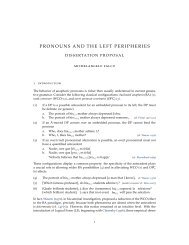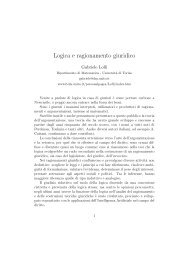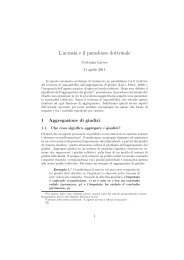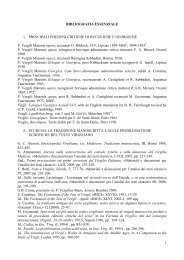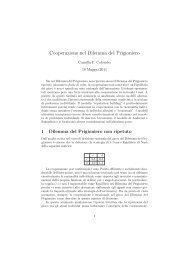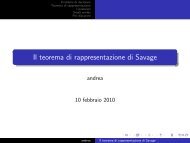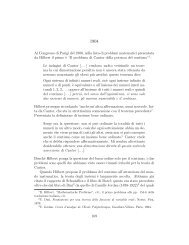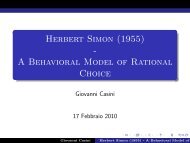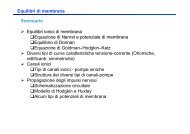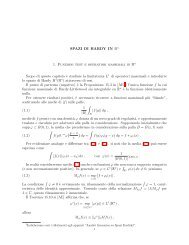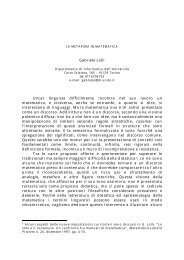Scavalcamento Debole e Catene in Forma Logica - Pagine ...
Scavalcamento Debole e Catene in Forma Logica - Pagine ...
Scavalcamento Debole e Catene in Forma Logica - Pagine ...
You also want an ePaper? Increase the reach of your titles
YUMPU automatically turns print PDFs into web optimized ePapers that Google loves.
1 – <strong>Scavalcamento</strong> <strong>Debole</strong>: Fenomeni e Analisi<br />
(1977) nota che molte costruzioni con movimento si comportano <strong>in</strong> maniera simile<br />
al movimento-wh rispetto ai fenomeni che lo avevano <strong>in</strong>dotto a postulare l’esistenza<br />
delle tracce e formula l’<strong>in</strong>fluente proposta che tutti i movimenti lasc<strong>in</strong>o tracce nella<br />
posizione di base dell’elemento mosso. Se accettiamo ques’idea ci aspettiamo che le<br />
costruzioni <strong>in</strong> questione <strong>in</strong>teragiscano con i pronomi allo stesso modo dei casi con<br />
movimento-wh. 8<br />
La determ<strong>in</strong>atezza, come abbiamo visto nell’analisi della BP, resta una nozione<br />
<strong>in</strong>tuitiva e <strong>in</strong> effetti i giudizi sulle costruzioni <strong>in</strong> cui essa gioca un ruolo sono soggetti<br />
a variazione <strong>in</strong>dividuale. Nonostante ciò esiste una stretta correlazione nei giudizi<br />
sulla pronom<strong>in</strong>alizzazione a ritroso nei casi di WCO. La correlazione emerge chiaramente<br />
nel caso di movimenti diversi dal movimento-wh. 9 Si confront<strong>in</strong>o i giudizi nel<br />
paradigma di BP <strong>in</strong> (10) con quelli dei casi di scissione <strong>in</strong> (11) e di topicalizzazioni<br />
<strong>in</strong> (12):<br />
(10) a. A man who had heard iti before <strong>in</strong>terrupted [Bill’s story]i.<br />
b. ?* A man who had heard iti before <strong>in</strong>terrupted [someone’s story]i.<br />
(Wasow, 1979, es. 18 app. II)<br />
(11) a. It was [Bill’s story]i that a man who had heard iti before <strong>in</strong>terrupted.<br />
b. ?* It was [someone’s story]i that a man who had heard iti before <strong>in</strong>terrupted.<br />
(Wasow, 1979, es. 19 app. II)<br />
(12) a. [Bill’s story]i, a man who had heard iti before <strong>in</strong>terrupted.<br />
b. ?* [Someone’s story]i, a man who had heard iti before <strong>in</strong>terrupted.<br />
(Wasow, 1979, es. 20 app. II)<br />
Nel caso delle <strong>in</strong>terrogative la specificità dei s<strong>in</strong>tagmi-wh è variabile. Le <strong>in</strong>terrogative<br />
con who, whose o what <strong>in</strong> (13) sono agrammaticali come le corrispettive<br />
costruzioni con un <strong>in</strong>def<strong>in</strong>ito <strong>in</strong> (14):<br />
(13) a. ?* Whoi did the woman hei loved betray?<br />
b. ?* [Whose story]i did a woman who had met himi before <strong>in</strong>terrupt?<br />
c. ?* [What]i did the man who lost iti need to f<strong>in</strong>d?<br />
(Wasow, 1979, es. 21 app. II)<br />
(14) a. ?* The woman hei loved betrayed someonei.<br />
8Lasnik e Stowell (1991) parlano di ipotesi del WCO generalizzato per riferirsi alla generalizzazione<br />
a tutte le catene Ā degli effetti di WCO. Wasow (1972, 1979) aveva di fatto già adottato<br />
quest’ipotesi.<br />
9È significativo che la proposta di un’unificazione completa fra i due fenomeni richieda, per<br />
essere colta, l’ipotesi del Crossover generalizzato.<br />
10



